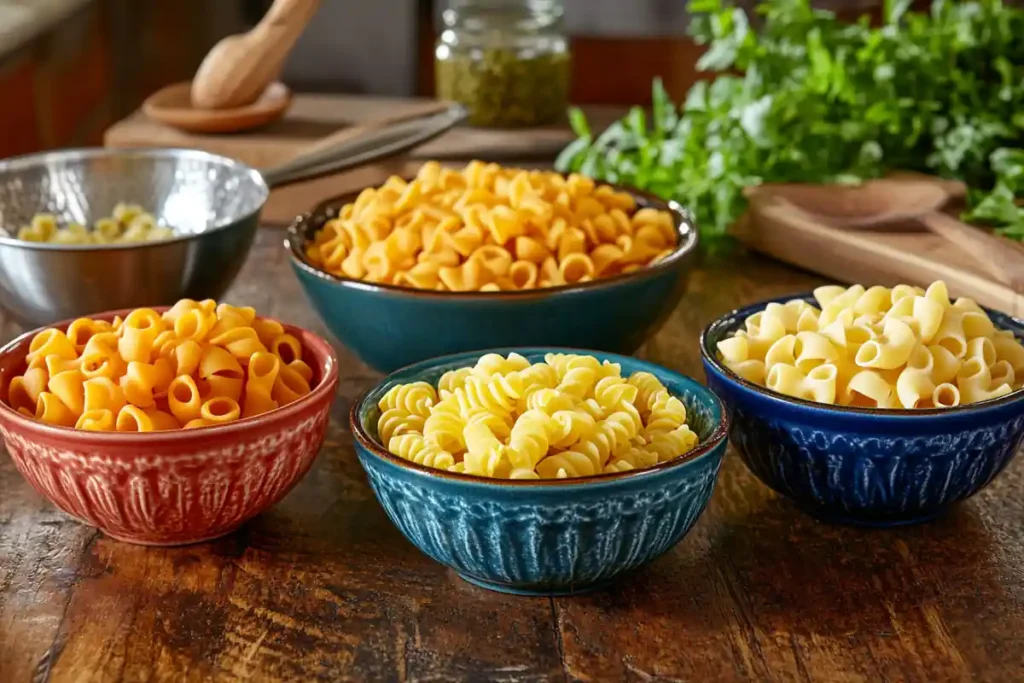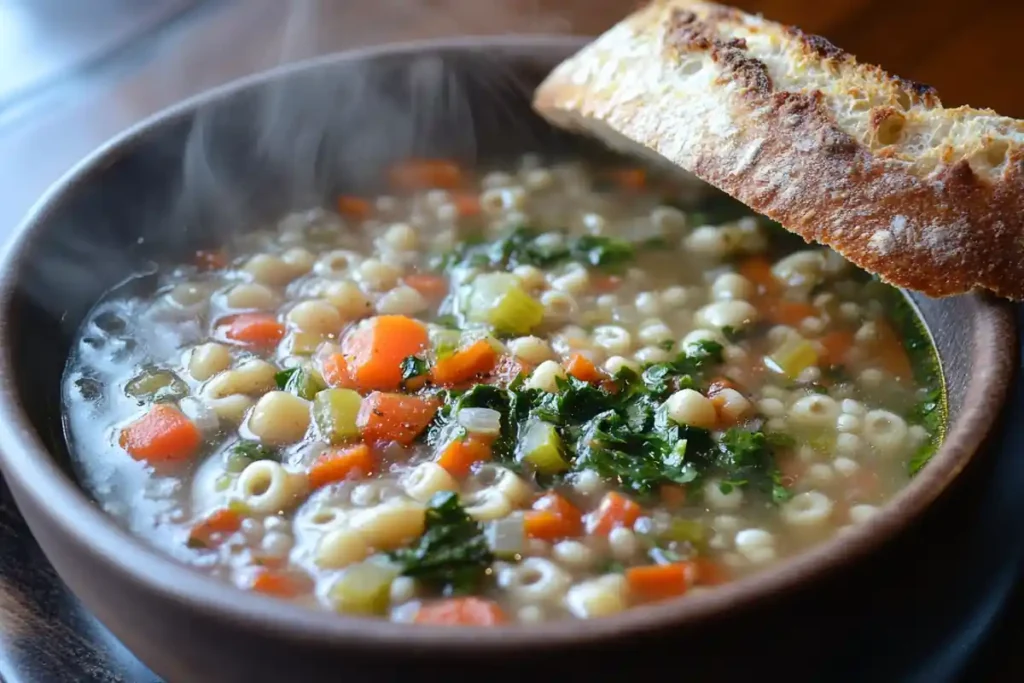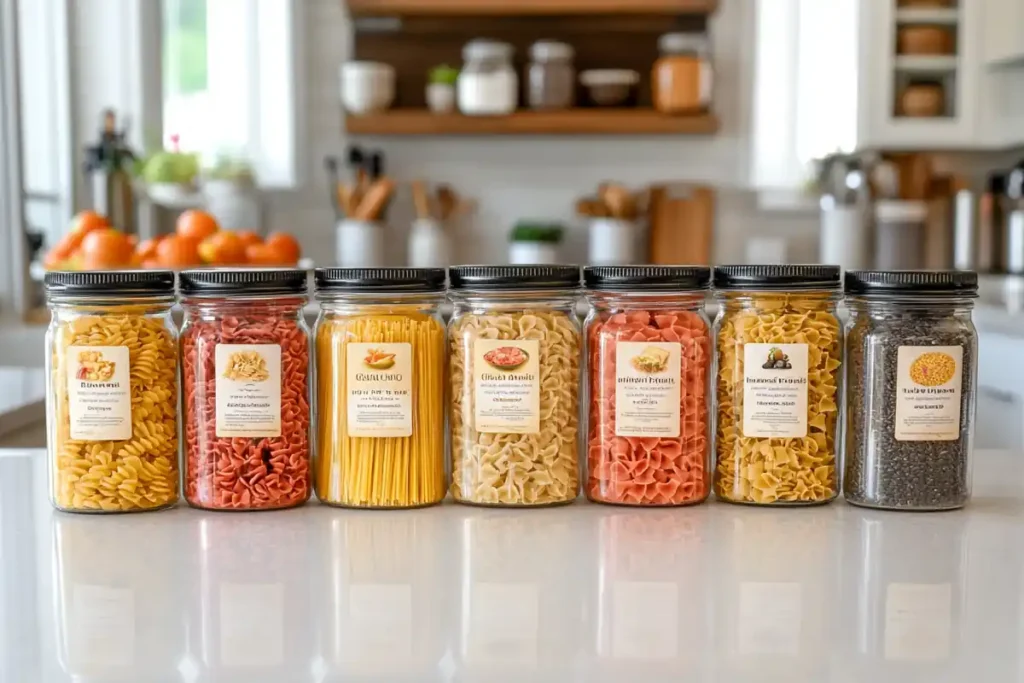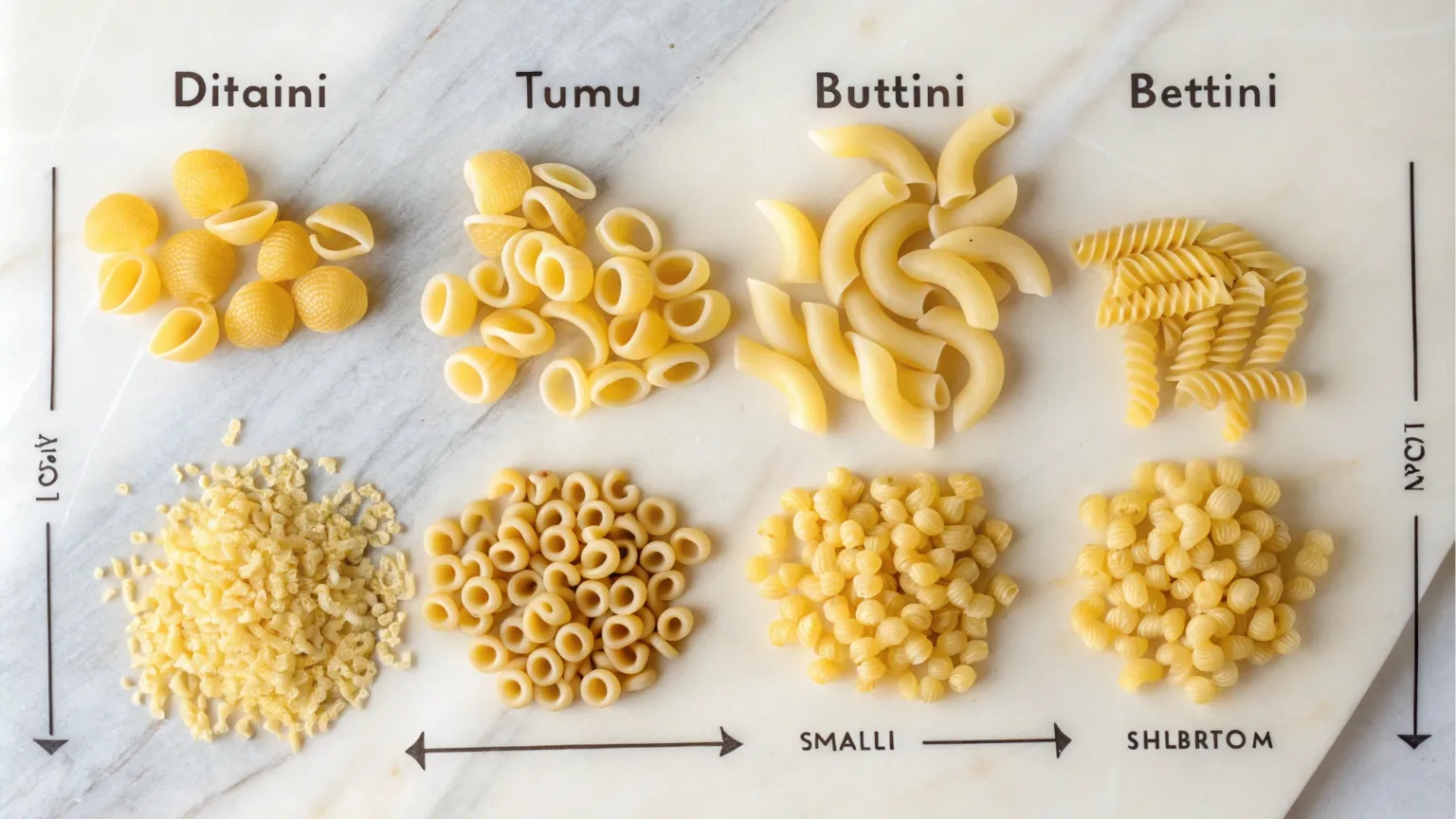Discover ideal substitutes for ditalini pasta, learn about their textures, shapes, and uses, and find the perfect option for your favorite recipes.
Many home cooks love ditalini for its tiny tubular shape and versatile uses. However, what is the closest pasta to ditalini? Sometimes you cannot find ditalini at the store. Consequently, you must consider other similar shapes that deliver a similar bite and texture. Basically, understanding which pastas resemble ditalini helps you prepare soups, salads, and casseroles without missing a beat. Indeed, several small pasta shapes come close to ditalini’s distinct profile. Accordingly, this comprehensive guide explores various alternatives, culinary tips, and more.
What Is the Closest Pasta to Ditalini? Understanding Ditalini’s Characteristics
Initially, consider what sets ditalini apart. Indeed, ditalini is a short, small pasta shaped like tiny tubes. Basically, it provides a firm, toothsome bite and holds sauces, broths, or dressings quite well. Because of its size, it works perfectly in hearty soups like pasta e fagioli. Furthermore, ditalini’s shape ensures even distribution of ingredients, making every spoonful uniform.
What Is the Closest Pasta to Ditalini? Key Attributes to Consider
When searching for substitutes, think about texture, size, and cooking time. Basically, ditalini’s short tubes cook quickly and evenly. Another factor involves how well they hold onto sauces. Thus, choose a pasta shape that can trap flavors similarly.
Identifying What Is the Closest Pasta to Ditalini? Based on Texture and Mouthfeel
Some pastas have ridges, while others are smooth. Comparatively, ridged surfaces grab onto sauce more easily. Conversely, smooth surfaces offer a cleaner texture. Equally, shape influences mouthfeel. Ditalini’s hollow center makes it feel light and delicate. Therefore, look for a shape with a similar hollow aspect or at least a small, rounded form.
Examining Shape Similarities to Discover What Is the Closest Pasta to Ditalini?
Shapes that resemble tiny tubes or short cut pasta often come closest. For example, small tubular pastas or small elbows mimic ditalini’s look and feel. Eventually, recognizing these structural resemblances makes selecting a substitute simpler.
For a deeper dive into the versatility of ditalini, check out Why Use Ditalini Pasta? A Comprehensive Guide.
What Is the Closest Pasta to Ditalini? Top Substitute Choices

When you want an almost identical replacement, consider tubettini. This shape looks like a slightly smaller tubular pasta, making it a top contender. Another worthy substitute is elbow macaroni, widely available and familiar. Small shells also work well because they trap sauces. Moreover, these common shapes ensure a consistent texture and cooking experience.
Tubettini: A Tiny Tubular Wonder
Tubettini might be the single best stand-in. Basically, it is ditalini’s close cousin, with a similar tubular structure and size. Consequently, it fits into soups, stews, and salads without issue. Its cooking time and mouthfeel remain quite close.
Elbow Macaroni: A Familiar, Accessible Option
Elbow macaroni ranks among the most common small pastas in American kitchens. Although slightly curved, elbows share a similar size to ditalini. Indeed, their hollow shape traps flavor. Furthermore, elbow macaroni is easy to find, making it a practical choice.
Small Shells: Holding Sauces Nicely
Small shells, or conchigliette, feature a scoop-like form. Although not tubular, they hold sauces and chopped ingredients admirably. Additionally, their shape feels satisfying in soups or salads, making them a worthy ditalini alternative.
Want to explore creative ways to use ditalini? Discover recipes in Ditalini Pasta Recipe: A Tasty Guide.
Additional Lesser-Known Options When Finding What Is the Closest Pasta to Ditalini?
If your local store lacks the common choices, consider lesser-known shapes. Acini di pepe, pastina, and stelline all serve as small pasta options. They differ slightly in texture, size, and application. Nonetheless, each can fill a similar role.
Acini di Pepe vs. Ditalini: Size and Application Differences
Acini di pepe are tiny, round pasta “grains.” They resemble small beads rather than tubes. Consequently, they provide a lighter, more delicate texture. Although not identical to ditalini, they work well in soups, adding a subtle thickness. However, acini di pepe might not hold sauce as well as tubular shapes.
Pastina: Tiny Shapes for Soothing Soups
Pastina refers to very small pasta shapes, often used in comforting broths. They vary in form, sometimes resembling small stars or grains. Pastina lacks the hollow center of ditalini. Nevertheless, they still create a comforting mouthfeel in soups. If you prioritize size over shape, pastina can suffice.
Specialty Pasta Shapes: Imported or Artisanal Alternatives
Specialty stores may offer unique small pastas. Mini-fusilli or other miniature cuts might approximate ditalini’s charm. Additionally, some artisanal brands craft tiny tubes that closely mimic ditalini. Indeed, exploring such products can lead to pleasant discoveries.
Culinary Applications: Using Close Substitutes Once You Know What Is the Closest Pasta to Ditalini?

After identifying a substitute, adapt your recipe accordingly. For soups, if you choose a smaller shape, adjust the amount of pasta to maintain balance. For salads, ensure the pasta complements the dressing and added ingredients. Because shapes vary, subtle tweaks ensure the final dish remains delicious.
Soups and Broths: Achieving Similar Consistency
In soups, ditalini often thickens the broth slightly and captures small vegetable bits. Another shape with a hollow center will behave similarly. If you pick a less hollow shape, consider adding slightly more pasta or a thicker broth. Eventually, you will master these adjustments with practice.
Pasta Salads: Maintaining That Perfect Bite-Size Texture
For cold salads, shape consistency matters. Ditalini ensures each bite contains a bit of everything. Substitute shapes that match size and texture to avoid uneven distribution. Small shells or elbows blend well with beans, diced veggies, and vinaigrettes.
Casseroles and Bakes: Ensuring Even Cooking
Baked dishes often rely on uniform pasta shapes that cook evenly. If you choose a shape similar in size and density, the casserole’s final texture remains cohesive. Ensure that the chosen pasta’s cooking time aligns with your recipe’s instructions.
Flavor and Texture Considerations
Although flavor mostly depends on sauces and seasonings, pasta shape influences perception. Ditalini’s hollow form allows sauces to settle inside, distributing flavor evenly. Substitutes with similar structures produce a comparable taste experience. Meanwhile, shapes that differ may alter how flavors integrate.
Balancing Creamy vs. Brothy Sauces
Thicker sauces cling to tubular shapes more effectively, enhancing creaminess. If your chosen substitute is smaller or rounder, consider thickening your sauce slightly. Similarly, brothy soups benefit from shapes that do not overwhelm the liquid base.
Adapting Seasoning for Different Shapes
If you switch from ditalini to another shape, taste-test before serving. Some pastas may require a pinch more salt or herbs. Eventually, you will learn how each shape absorbs and reflects flavors, allowing fine-tuning as needed.
Achieving Desired Consistency in Final Dishes
Ditalini lends a pleasant chewiness. If a substitute feels too soft, cook it a minute less next time. Conversely, if it seems too firm, extend the boiling time slightly. Adjusting cooking times ensures the mouthfeel matches what you love about ditalini.
Health and Nutritional Factors of Ditalini Substitutes

When exploring substitutes, consider nutritional aspects. Whole-wheat or gluten-free options exist for many small shapes. These alternatives can enhance fiber content, accommodate dietary restrictions, or simply align with personal preferences.
Whole-Grain Varieties for Fiber Boost
Whole-grain pasta often provides more fiber and nutrients than refined versions. If you find a whole-wheat elbow macaroni or small shell, you gain the same benefits as ditalini, plus improved nutrition. Thus, healthy swaps become easy.
Gluten-Free Options: Corn, Rice, or Legume-Based Pastas
If you avoid gluten, consider corn or rice-based small pastas. Although the texture may differ slightly from wheat-based ditalini, you can still achieve a similar dish. Legume pastas, made from lentils or chickpeas, add protein and unique flavor as well.
Nutritional Tips for Balanced Meals
No matter which substitute you pick, round out your meal with vegetables, lean proteins, and healthy fats. A balanced dish ensures that the pasta remains part of a nutritious, satisfying plate.
Cultural and Regional Perspectives
Ditalini features prominently in Italian cuisine, but small pasta shapes appear in many cultures. By understanding these culinary traditions, you can appreciate the versatility of these tiny formats. Eventually, you might discover new recipes that celebrate these shapes in unexpected ways.
Mediterranean Soups and Stews
Small pasta adds body to soups throughout the Mediterranean region. Indeed, recipes vary, but the concept remains similar. If you cannot find ditalini, experiment with local small shapes that local cooks prefer.
Italian Pasta Traditions and Ditalini’s Role
In Italy, ditalini frequently stars in hearty soups. Italians value pasta shapes that complement the other ingredients. Choosing a close substitute aligns with this tradition and keeps your dish authentic in spirit.
North American Adaptations
Americans often use small shapes in macaroni salads, casseroles, and pantry-friendly meals. With a range of tiny pastas readily available, you can easily find a suitable replacement for ditalini. Ultimately, these culinary overlaps make substitutions stress-free.
Troubleshooting and Practical Tips for Pasta Similar to Ditalini
Switching to a new shape sometimes introduces minor challenges. Overcooking a smaller pasta can result in mushiness. Conversely, undercooking a sturdier shape leads to a tougher bite. By monitoring cook times and tasting as you go, you’ll achieve a perfect texture.
Cooking Time Guidelines for Similar Shapes
Check package instructions for your chosen substitute. If it says 7–9 minutes, start checking at 6 minutes for al dente results. This precaution ensures you retain control over the final texture.
Preventing Overcooking and Mushiness
If making soup, add pasta near the end of cooking. This method prevents it from soaking too long and becoming soft. Similarly, if you prepare a casserole, slightly undercook the pasta before baking, so it finishes cooking in the oven.
Reheating and Maintaining Quality
Leftover pasta-based dishes sometimes lose texture. Reheat gently, adding a splash of water or broth if necessary. Stir often and consider adding fresh herbs or cheese after warming to revive flavors and textures.
Frequently Asked Questions (FAQs)
What pasta can I substitute for ditalini pasta?
You can try small tubular shapes like tubettini or elbow macaroni. Additionally, small shells also work well. These choices resemble ditalini’s size and texture closely. As a result, they create a similar overall experience in soups, salads, and casseroles.
Is ditalini the same as acini di pepe?
No, they differ in size and shape. Acini di pepe are tiny, round “peppercorn”-like pasta. Conversely, ditalini are short tubes. Although both suit soups, ditalini’s hollow shape differs from the bead-like acini di pepe.
Is ditalini pasta the same as macaroni?
Not exactly. While ditalini and elbow macaroni are both short, elbow macaroni has a curved shape and sometimes a slightly larger size. Ditalini, on the other hand, are straight, short tubes. Still, elbow macaroni works well as a substitute due to its similar cooking time and ability to hold sauce.
Is ditalini similar to pastina?
Pastina refers to very small pasta shapes, often smaller than ditalini. Pastina might look like tiny stars or grains rather than tubes. Although not identical, pastina works in soups for a soothing texture, but it lacks the hollow center and tubular structure that define ditalini.
Conclusion: Finding the Closest Pasta to Ditalini
Ultimately, answering what is the closest pasta to ditalini? depends on understanding each shape’s size, texture, and culinary uses. Tubettini often emerges as the best match, but elbow macaroni and small shells also shine as worthy alternatives. Indeed, experimenting with these substitutes reveals their versatility in soups, salads, and comforting casseroles. By considering shape, cooking times, and flavor absorption, you can confidently swap ditalini with a suitable stand-in. Undoubtedly, this flexibility ensures your favorite recipes remain flavorful and appealing, even if your pantry lacks ditalini.
Looking for more? Check out our other links for even greater insights and inspiration!

